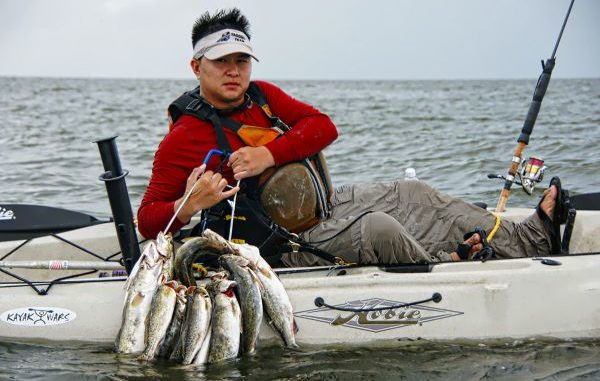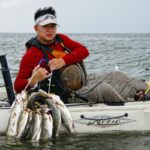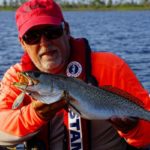
It’s the time ’yakers dream about
The days are shorter, the temperature is cooler and the specks are closer. Fall is the best time to target speckled trout from a kayak: The fish are hungry, concentrated and easy to reach.
Catching fat, spawning speckled trout in spring and summer is certainly a blast, but the action is often inconsistent, and usually means driving and paddling farther to get to the fish.
However, that all reverses in the fall as they move back to the marshes where kayakers can easily get to them with minimal effort.
“I love fishing for trout in the fall. While the fish are generally smaller, it’s easier to catch a limit, and there are always those few nice ones mixed in,” James Kellum said.
An avid kayak angler, Kellum lives in St. Bernard and regularly fishes the Hopedale and Delacroix areas.
Triggered by a drop in water temperature and shorter daylight hours, the cycle of marine life begins a march back into the coastal marshes at the end of summer. Like a light switch, areas where you might have found only a few trout in the preceding months, turn on — sometimes literally overnight.
The marsh is filled with white shrimp, pogies, mullet and cochahoe minnows, and the trout know it.
Live bait remains easily available. As long as shrimp remain in the marsh, the trout will eat them and the bait dealers will have them for sale.
As fall turns to winter, shrimp become scarce and cochahoes will be the only viable live-bait option.
Although readily available and certainly effective, live bait is a matter of choice, and usually not a necessity. Trout are active and hungry. They can easily be caught using a wide variety of artificial lures and techniques.
This is great news for kayakers, as it eliminates the need to use a livewell or pull around drag-causing live-bait containers.
A great compromise between live bait and plastic is the use of scented artificial baits such as Gulp. They provide the scent of live bait with the durability and ease of use of plastics. And they are available in a wide variety of shapes, sizes and colors.
Go through your tackle and downsize to your favorite confidence baits. Soft-plastic tails, a variety of jigheads and hard baits with different actions are all you need.
Fall trout will be found throughout the water column, so having a variety of lures to fish from the surface to the bottom helps find and catch them, no matter where they are on a particular day.
There’s no denying the effectiveness of a popping cork. Long a Louisiana marsh staple, these noise makers are highly effective on schooling trout.
Popping corks are easy to cast with leaders of up to 4 feet. If the fish are holding deeper than that, switching to a sliding cork makes casting easier, and the cork can be adjusted for depth without having to retie.
Plastic tails are more a matter of personal choice than fish preference. Most are similar in size and shape, and are designed to mimic two of the trout’s favored foods — shrimp or minnows.
Both styles are effective.
Color does matter. Marsh water in the fall tends to be clearer; therefore, lighter colors are better. However, cold-front winds and associated low tides can create muddy or off-colored water overnight.
So when selecting your favorite soft-plastic colors, just make sure they range from clear to black.
Tight-lined or under a cork, jigheads are also more important to anglers than the trout.
Under a cork, lighter heads from 1/8 to ¼ ounce are usually best to get the bait to quickly sink but still have fish-enticing action when the cork is popped. Heads up to 3/8 ounce might be necessary if fish are holding in deeper holes, especially if the current is strong.
Drifting or trolling also are good methods to fill the ’yak with hungry fall trout. Kayaks are quiet and can easily drift or troll across areas without spooking the fish.
Both techniques can be just as productive in deeper canals and pipelines as they are in large lagoons and bays. The key to the technique is for the bait to bounce along the bottom as the kayak pulls it along.
If you’re not feeling the bottom, you likely won’t catch fish.
The best jighead weight is determined by the speed of the kayak and the depth of the water. In deeper areas, letting out more line will help get the bait to the bottom and keep it in the strike zone.
Hard-plastic lures also are killer fall trout baits. While many think topwater fishing is a summer-only technique, trout can be fooled with topwater baits year round.
In fact, fall topwater action can be fantastic. If you don’t throw a topwater bait on every trip, you might not know what you’re missing.
Other hard- and soft-plastic lures can be just as effective. Suspending and sinking lures are good search baits to find where and at what depths fish are holding.
Fall trout often school according to conditions. Fan cast an area 360 degrees before deciding to move on.
Oftentimes the trout might not be where you expect them. While the usual points, cuts and shorelines are often prime spots, sometimes fish are holding in the middle of nowhere.
Thoroughly fishing an area might be the difference between a skunk and a limit. Always have a lure in the water — whether casting or trolling.
And fishing while you are heading to an intended spot might mean that you never have to get there.
Fall speckled trout and kayak fishing are made for each other. You can often catch limits within sight of where you launch. Short paddles, comfortable conditions and minimal gear are what kayak fishermen dream about.




